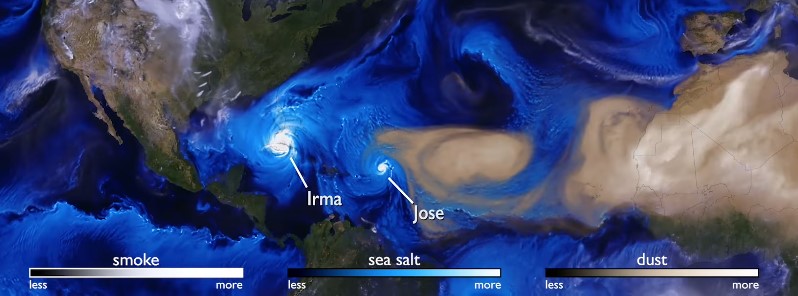Currents in the atmosphere and 2017 Atlantic hurricanes

Tracking the aerosols carried on the winds let scientists see the currents in our atmosphere. This visualization follows sea salt, dust, and smoke from July 31 to November 1, 2017, to reveal how these particles are transported across the map.
The first thing that is noticeable is how far the particles can travel. Smoke from fires in the Pacific Northwest gets caught in a weather pattern and pulled all the way across the US and over to Europe. Hurricanes form off the coast of Africa and travel across the Atlantic to make landfall in the United States. Dust from the Sahara is blown into the Gulf of Mexico. To understand the impacts of aerosols, scientists need to study the process as a global system.
During the 2017 hurricane season, the storms are visible because of the sea salt that is captured by the storms. Strong winds at the surface lift the sea salt into the atmosphere and the particles are incorporated into the storm.

Hurricane "Irma" is the first big storm that spawns off the coast of Africa. As the storm spins up, the Saharan dust is absorbed in cloud droplets and washed out of the storm as rain.
This process happens with most of the storms, except for Hurricane "Ophelia." Forming more northward than most storms, Ophelia traveled to the east picking up dust from the Sahara and smoke from large fires in Portugal. Retaining its tropical storm state farther northward than any system in the Atlantic, Ophelia carried the smoke and dust into Ireland and the UK.
Credits:
- Matthew R. Radcliff (USRA): Lead Producer
- Aaron E. Lepsch (ADNET Systems, Inc.): Technical Support
- William Putman (NASA/GSFC): Lead Scientist
- Anton S. Darmenov (NASA/GSFC): Scientist
- Ellen T. Gray (ADNET Systems, Inc.): Narrator
- Music: Elapsing Time by Christian Telford [ASCAP], Robert Anthony Navarro [ASCAP]
Featured image credit: NASA

Commenting rules and guidelines
We value the thoughts and opinions of our readers and welcome healthy discussions on our website. In order to maintain a respectful and positive community, we ask that all commenters follow these rules.